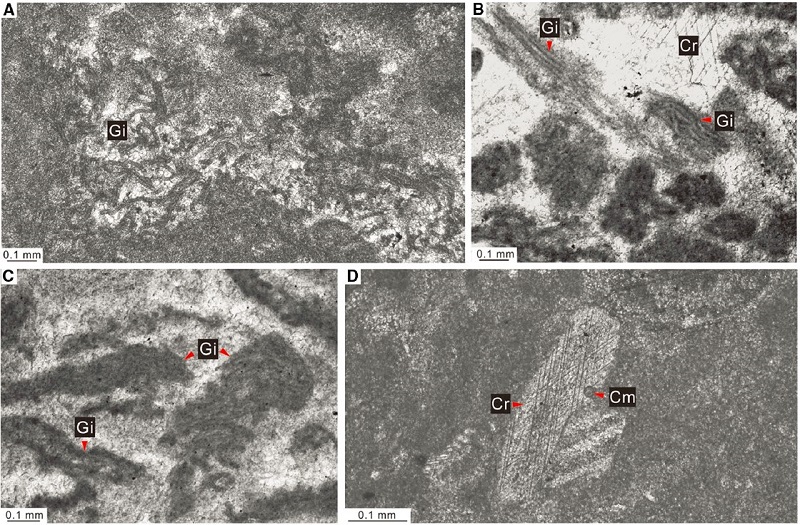With a prominent disparity in the morphology and the microfabric, stromatolites occur widely in the fossil record of the Precambrian. Noticeably, they show a long-term decline in abundance throughout the Proterozoic. The decline tendency continued in the Phanerozoic, while the Cambrian and Early Ordovician record a resurgence of microbialites. It has long been known that the Ordovician marks a changeover from microbial to metazoan-dominated reefs. However, by the Early Ordovician, the abundance of stromatolites achieved Neoproterozoic- to Mesoproterozoic- like prevalence, based on the latest rock record–normalized occurrence analyses.
Cooperated with Dr. Stephen Kershaw of the Brunel University, Dr. LI Qijian from Nanjing Institute of Geology and Palaeontology, Chinese Academy of Sciences(NIGPAS) leaded and conducted a study on the microbial reefs of the Lunshan Formation in southern Anhui Province. The team systematically collected stromatolite samples from the Lunshan Formation of various sections and conducted in-depth studies through microscopic slices. Related results have been published online in the international journal Facies.
In the eastern Yangtze Platform of South China Block, Tremadocian (Early Ordovician) stromatolites occur along a palaeoenvironmental transect from the shallowest intra-platform setting through to deeper platform margin. The intra-platform and platform margin belts of Tremadocian rocks in the eastern platform are carbonate-dominated marine environments favourable for calcimicrobes. However, stromatolites are absent in siliciclastic-dominated slope facies.
Shallower carbonate facies are represented by the upper member of the Lunshan Formation, composed of a hundred metres thickness of stromatolite-bearing carbonates. Such stromatolites at the Beigong section of Jinxian county are characterized by stratiform and dome-shaped laminations. Girvanella filaments are ubiquitous in thin sections (Fig 1). Crinoids grew on the surfaces of the microbialites. In contrast, towards the deeper carbonate platform margin, stromatolites in massive-bedded limestones of the upper member of Lunshan Formation of the Ma’anshan section at Shitai occur as dense columns of bindstones; macrofossils and bioclasts are rare in those stromatolites, indicating a lower energy and deeper marine setting. Water depth at the platform margin of the Ma’anshan section is interpreted as being above the base of the euphotic zone (Fig 2); however, benthic fauna notably declined. In contrast to shallower settings, in clastic-dominated locations interpreted as deposited in deeper water, stromatolites are absent, represented by the middle member of Dawuqian Formation at the Ziliqian section. This work, therefore, supports that Early Ordovician reef systems were still microbial-dominated, representing the last golden age of stromatolites.
This study was financially supported by the Youth Innovation Promotion Association, the National Natural Science Foundation of China, and the Chinese Academy of Science. This study is a contribution to the IGCP-653‘The onset of the Great Ordovician Biodiversity Event’ and the IGCP Project 668 ‘The stratigraphic and magmatic history of Early Palaeozoic equatorial Gondwana and its associated evolutionary Dynamics’.
Reference: Yu, Shenyang., Li, Qijian*., Kershaw, Stephen. et al. Microbial reefs in eastern Yangtze Platform, South China Block: the last golden age of stromatolites in the Ordovician. Facies 66, 12 (2020). (DOI: https://doi.org/10.1007/s10347-020-0596-x)

Fig 1.Microfacies of the lithological types of the stromatolitic units, upper member of the Lunshan Formation at Beigong section of Jinxian. A) Tangled filaments of Girvanella (Gi); B) Linear and tangled filaments of Girvanella (Gi) and crinoidal fragment (Cr); C) tangled filaments of Girvanella, some filaments are recrystallized as spars, BG-3; D) calcimicrobial(Cm) encrusts on the borings of crinoid (Cr) fragments.

Fig 2.Environmental reconstruction interpreting the biotic and lithological facies changes controlled by bathymetric deeping and decreased photosynthesis of marine-floor along the transition between the Lunshan and Dawuqian formations in the Tremadocian, southern Anhui.
Download:
